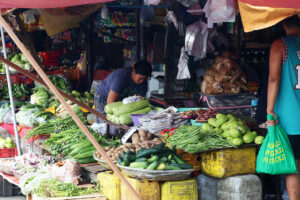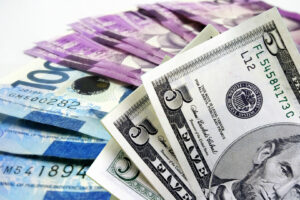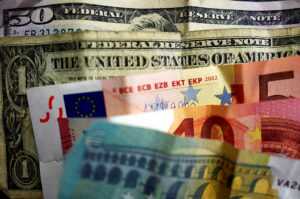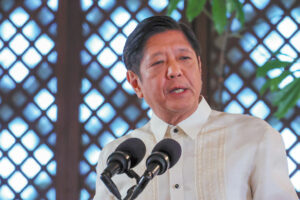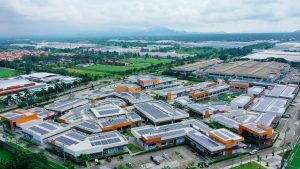By Aubrey Rose A. Inosante, Reporter
HEADLINE INFLATION slowed to its lowest in over five years in April, amid a drop in food prices and transport costs, the Philippine Statistics Authority (PSA) said, giving the central bank room to further cut rates.
Preliminary data from the PSA showed the consumer price index rose to 1.4% in April, slowing from 1.8% in March and 3.8% a year ago.
The April print was at the low end of the Bangko Sentral ng Pilipinas’ (BSP) 1.3% to 2.1% forecast. It was also below the 1.8% median estimate in a BusinessWorld poll of 14 analysts last week.
At 1.4%, this was the lowest inflation in 65 months or since the 1.2% in November 2019.
April also marked the ninth straight month that inflation settled within the central bank’s 2-4% target range.
For the first four months of 2025, inflation averaged 2%.
The BSP in a statement said the latest inflation outturn is “consistent with its assessment of a manageable inflation environment over the policy horizon.”
However, it noted a “more challenging external environment, which would dampen global GDP (gross domestic product) growth and pose a downside risk to domestic economic activity.”
“On balance, the more manageable inflation outlook and the downside risks to growth allow for a shift toward a more accommodative monetary policy stance,” the central bank said.
“Looking ahead, the BSP will continue to take a measured approach in deciding on further monetary easing.”
The Monetary Board resumed its easing cycle in April with a 25-basis-point rate cut, bringing the key rate to 5.5%.
PSA data showed core inflation, which discounts volatile prices of food and fuel, stood at 2.2% in April, same as March. It slowed from 2.4% in April last year.
“The main reason for the lower inflation rate in April 2025 compared to March 2025 is the slower increase in the prices of Food and Nonalcoholic beverages at a rate of 0.9%,” National Statistician Claire Dennis S. Mapa said on Tuesday.
The food and nonalcoholic beverages index in April sharply slowed from 2.2% in March and 6% in the same month in 2024.
Food inflation further eased to 0.7% in April from 2.3% in March and 6.3% in the year prior.
Rice inflation further contracted to 10.9% in April from the 7.7% decline in March, Mr. Mapa said.
According to Mr. Mapa, the average price of a kilo of regular milled rice nationwide fell by 13.3% to P44.45 in April compared with P51.25 in the same month last year.
The average price of a kilo of well-milled rice also dropped by 10.4% to P50.54 in April from P56.42 in April 2024.
On the other hand, the price of a kilo of special rice fell by 6.2% to P60.69 from P64.68 in the same month a year earlier.
“The slower growth in vegetable prices also helped those with higher weights [in the basket]. Of course, we saw a slow down on fish,” Mr. Mapa said.
Vegetables, tubers, plantains, cooking bananas and pulses slowed to 2.3% in April from 6.9% a month prior.
Lower inflation was also recorded for fish and other seafood at 4.3% in April from 5.5% in March.
Pork inflation eased to 10.3% in April from 10.8% in March.
“It’s a slight drop, but the price difference is still substantial because it’s still around 10%. As I mentioned earlier, in our food basket, the prices of pork and chicken are the two items that have really contributed. The price of pork is still quite high,” Mr. Mapa said.
He said that the average retail price of fresh pork kasim rose by 9.5% to P364.79 per kilo in April from P333.29 in the same month in 2024.
The price of fresh pork belly (liempo) in April increased by 9.7% to P381.02 per kilo from P374.20 a year ago.
“The sustained slowdown in inflation, driven largely by the significant decline in food prices, is a positive sign that our policy interventions are working. We will continue to implement strategies to vigilantly monitor price shocks and proactively temper inflationary pressures,” said DEPDev Undersecretary for Planning and Policy Group Rosemarie G. Edillon.
TRANSPORT COSTSLower transport costs were also a source of slower inflation in April, Mr. Mapa said.
The transport index declined at a faster pace to 2.1% in April from the 1.1% dip in March.
Gasoline prices declined at a quicker pace at 12.4% in April from the 7.5% drop in the month prior. Diesel costs also dropped at a faster pace to 8.3% in April from the 5% dip in March.
Asked if the recent Light Rail Transit (LRT) Line 1 fare hike affected the inflation rate, Mr. Mapa said the weight of passenger transport by train in the overall inflation basket is minimal.
Starting April 2, the boarding fare at LRT-1 was increased to P16.25 from P13.29, while the distance per kilometer fare was hiked to P1.47 from P1.21.
Meanwhile, the PSA said inflation for housing, water, electricity, gas and other fuels quickened to 2.9% in April from 1.7% increase in March. This was one of the main contributors to headline inflation as it accounted for a 39.5% share.
Manila Electric Co. raised the overall rate by P0.7226 per kilowatt-hour (kWh) to P13.0127 per kWh in April from P12.2901 per kWh in March.
PSA data showed inflation for the bottom 30% of income households further decelerated to 0.1% in April from 1.1% in March and 5.3% a year ago.
Inflation in the National Capital Region (NCR) accelerated to 2.4% in April from 2.1% in March. Outside NCR, inflation slowed to 1.2% from 1.8% in the previous month.
HSBC economist for ASEAN Aris D. Dacanay said April inflation was well below market expectations as lower food prices offset the rise in electricity rates.
“Though electricity rates and train fares were hiked during April, the decline in food prices was more than enough to bring inflation down. Not only did rice prices soften, but meat, fruits, and vegetable prices also moderated, signifying better supply conditions in the economy,” he said.
Mr. Dacanay noted the strong peso against the US dollar helped bring pump prices down.
“All in all, the weak inflation print is good news for the Philippine economy at a time when uncertainty looms over the outlook of trade and the global economy. Subdued price pressures will likely help bolster the country’s main driver of growth — consumption,” he said.
In an e-mailed report, Chinabank Research said in the coming months, it expects inflation to remain subdued and manageable due to benign price pressures, government initiatives to stabilize food prices, and favorable base effects.
Chinabank also said that the favorable domestic conditions could help to temper any potential negative effects from higher US tariffs and global policy uncertainties.
CUT IN JUNE?Meanwhile, the BSP said the risks to the inflation outlook continue to be broadly balanced from 2025 until 2027.
“Upside pressures come from possible increases in transport charges, meat prices, and utility rates. Meanwhile, downside risks are linked to the continuing effects of lower tariffs on rice imports and the expected impact of weaker global demand,” it added.
Finance Secretary and Monetary Board member Ralph G. Recto said the lower-than-expected inflation gives the BSP room to further cut rates “to help us further boost the spending power of Filipinos, drive in more investments, and grow the economy, especially amid rising global uncertainties.”
The BSP’s next policy meeting is on June 19.
Nicholas Antonio T. Mapa, chief economist at Metropolitan Bank & Trust Co., said the BSP’s recent statement represents a “dovish departure” for BSP Governor Eli M. Remolona, Jr.
“We expect BSP to cut in June with RRP (reverse repurchase) rate possibly brought down to 4.75% should the inflation outlook remain manageable,” he said via Viber chat on Tuesday.
For his part, Mr. Dacanay said he expects the next policy rate cut to be in August, not June.
‘But with how much inflation has been surprising to the downside, there is a risk of the BSP cutting its policy rate earlier and, perhaps, by more, to as low as 4.75% by yearend,” he said.


